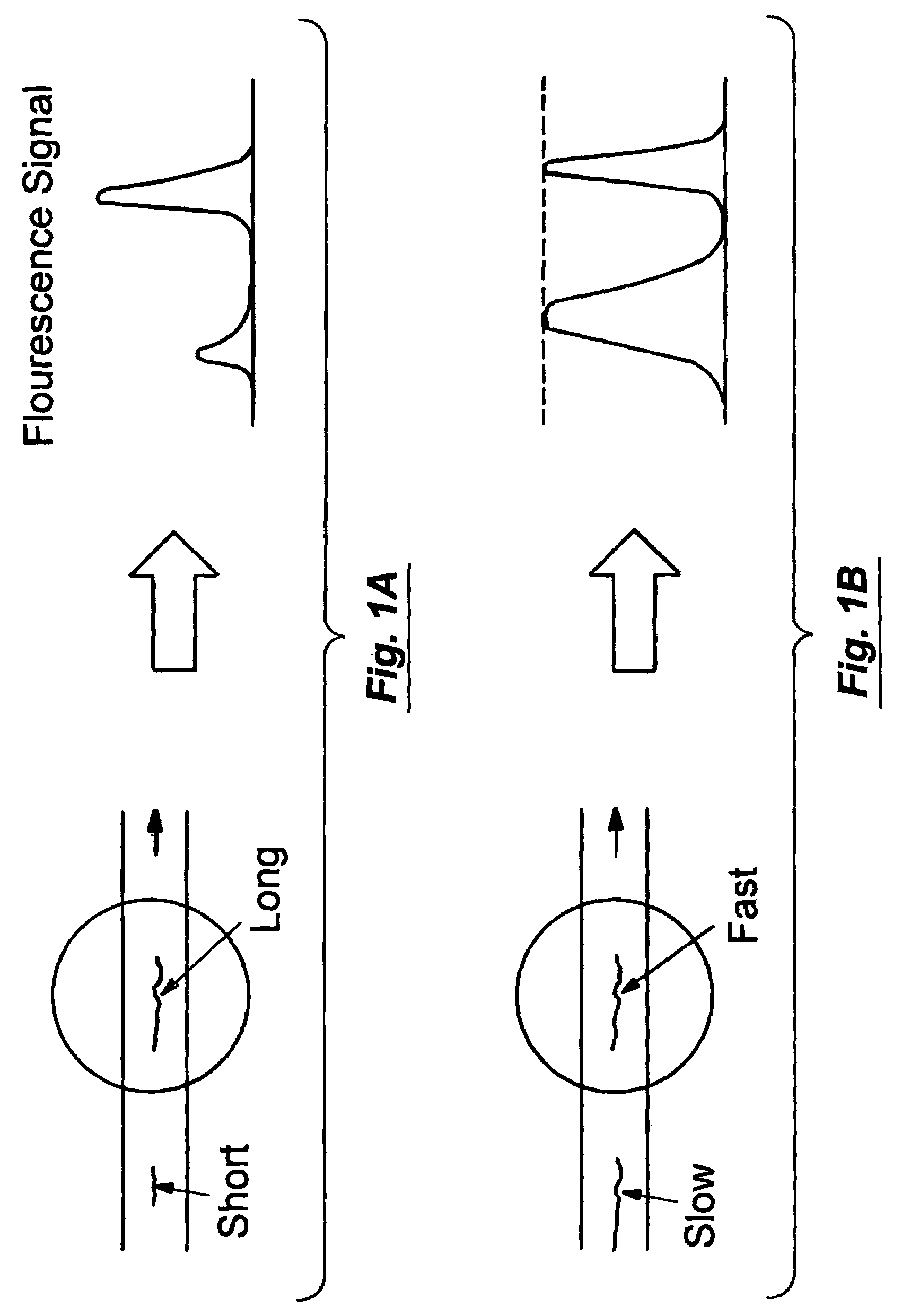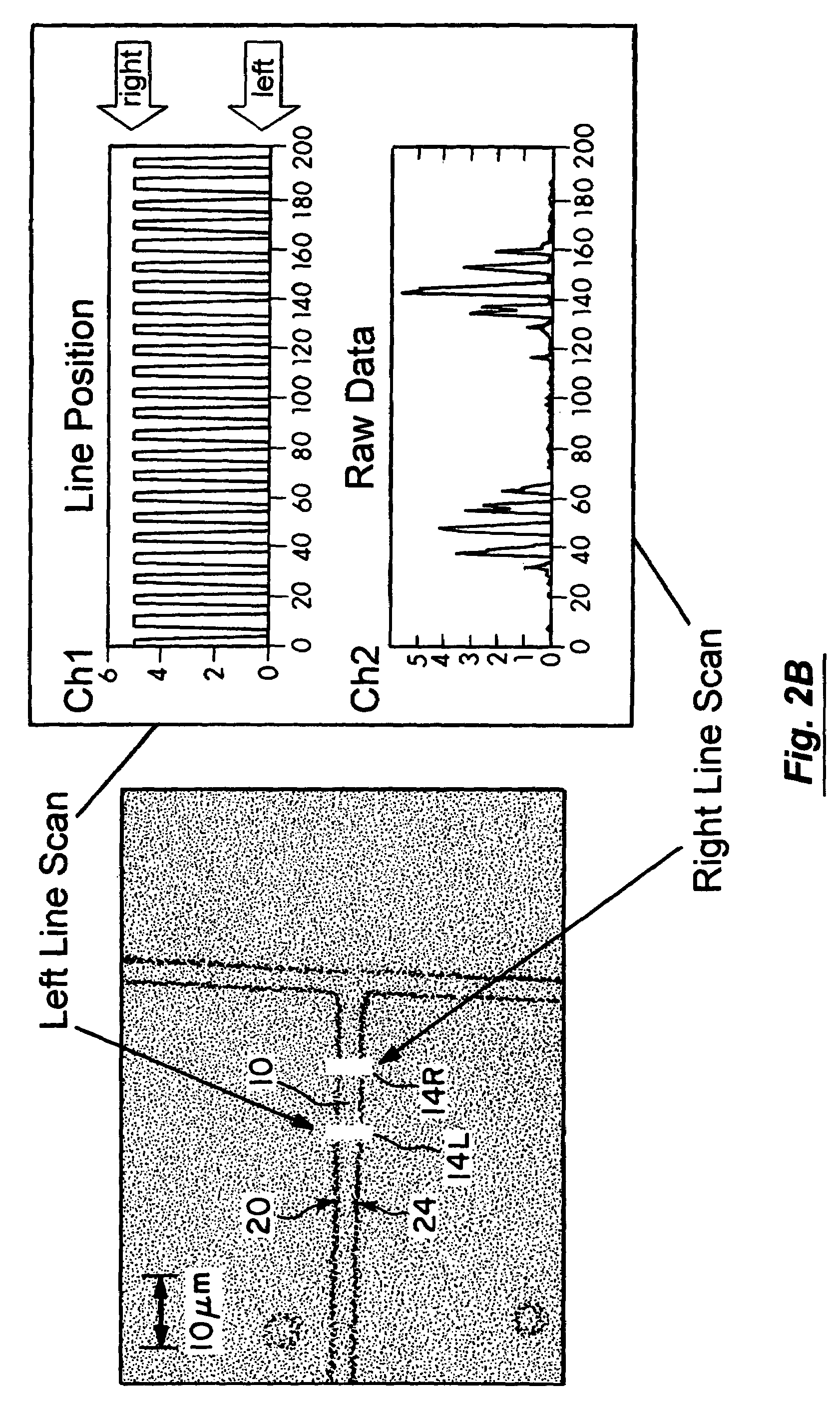Velocity independent analyte characterization
- Summary
- Abstract
- Description
- Claims
- Application Information
AI Technical Summary
Benefits of technology
Problems solved by technology
Method used
Image
Examples
example 1
[0085]This example illustrates the method of measuring flow velocity of particles.
[0086]A solution of fluorescent beads (FluoSpheres Biotin Labeled microspheres 0.2 μm, yellow green fluorescent, Molecular Probes) were introduce into the microfluidic device and their velocity were measured. The flow of fluorescent beads was achieved by capillary flow in the microfabricated channels sealed by coverslips. A histogram of the bead flow velocities is seen in FIG. 5 for a later time in the experiment in which the transient stage is over and the velocity distribution become roughly constant. Assuming uniform distribution of beads in the channel, the theoretical probability, Ppr, of a particle with velocity ν0 to pass through the cross section in a given time is given by the equation:
[0087]Ppr(v=v0)=v0Pv(v=v0)∫vPvⅆv
where Pν is the probability to have a velocity v in the cross section of the channel. In circular tubes Pν is constant for νmax for Poiseuille flow. The rectangular cross sect...
example 2
[0088]In the next experimental stage a solution of a mix of two kinds of beads (Component A and B, LinearFlow green flow cytometry intensity calibration kit, 2.5 μm, Molecular Probes) which were similar in every other aspect besides their fluorescent intensity was introduce to the system. The fluorescent intensity of the beads was collected by the channel photomultiplier for a period of 400 sec. For each passing particle, the normalized area and velocity were calculated.
[0089]The velocity as a function of time was plotted. See FIG. 4. The flow in the system is capillary flow and is driven by the pressure difference between the ends of the channel. During the time of the experiment, the pressure at the beginning of the channel, originating from the fluid at the starting basin, decreases while the pressure at the output increases. This pressure change results in a decay in the velocity over time, as shown in FIG. 4 (t>20 sec). The abrupt change in the velocity, which occurs at about 2...
example 3
[0092]Lambda phage DNA (GIBCO) was diluted in buffer (Tris EDTA, pH 6.8 with 5 mM NaCl) and stained with the intercalating dye C49H58I4N6O2, marketed as YOYO®-1 (Molecular Probes) at a stochiometry of one dye molecule per 4 bp.
[0093]Then a solution of stained λ DNA was introduced to the microfluidic device for a period of 5 minutes. A histogram of the normalized areas of the molecules is plotted and is shown in FIG. 6. The center peak in the histogram corresponds with the λ DNA (48 kbp) and the small peak in the right corresponds with hybridized pairs of λ DNA (96 kbp), i.e., λ2. The CV for the λ and λ2 peaks were 8.34% and 7.61%, respectively, and the ratio between the centers of the two peaks was 2.06.
PUM
 Login to View More
Login to View More Abstract
Description
Claims
Application Information
 Login to View More
Login to View More - R&D
- Intellectual Property
- Life Sciences
- Materials
- Tech Scout
- Unparalleled Data Quality
- Higher Quality Content
- 60% Fewer Hallucinations
Browse by: Latest US Patents, China's latest patents, Technical Efficacy Thesaurus, Application Domain, Technology Topic, Popular Technical Reports.
© 2025 PatSnap. All rights reserved.Legal|Privacy policy|Modern Slavery Act Transparency Statement|Sitemap|About US| Contact US: help@patsnap.com



